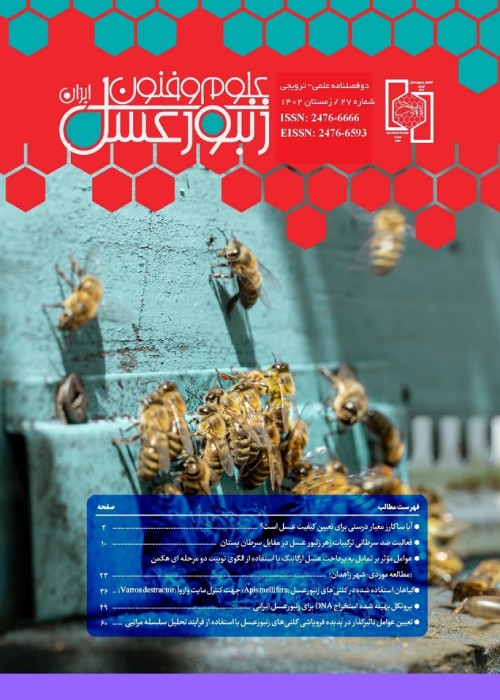The Plant Sources of Propolis from Cupressaceae in Iran
Abstract:
The opposite of Pinaceae which dose not have any endemic species in Iran، Cupressaceae has three Genera in titled Cupressus، Juniperus and Thuja whit several natural spesies and under species taxa in Iran. From genus Cupressus، there are spesies Cupressus sempervirens and three variety in titled C. sempervirens var. horizontalis، C. sempervirens var. cereiformis and C. sempervirens var. fastigiata which is naturaly distributed in Iran. In these varieties، C. sempervirens var. horizontalis has producted several high density populations in Sepidrood and Chaloos valleys during 300m to 700m altitudes above sae level on lime soils and lime stones. This variety has producted pure and condensed the Cupressetum sempervirens var. horizontalis association in Emamzadeh Hashem، Rostam Abad، Roodbar and Manjil mountains in Sepidrood valley. The great area of Chaloos valley is covered by this species too. This species is ditributed in Pole Zoghal and Marzan Abad to 700 m altitude. There is one secretory resin and gum pore on the back surface of each scale leaf in this genus. These communities are the most important sources of propolis in these areas. Cupressus arizonica is brought from south of America which is cultivated in parks and green spaces in Iran. In C. arizonica، in addition to resin seretory from the leaf pore، a great volume of resin is also secreted from stem and shoots. But in the endemic species of this genus، the resin secretory is just happened from back surface of scale leaf. C. arizonica is one of the most important sources of resin and gum secretory in this family. The alone species of genus Thuja in Iran is Thuja orientalis which have formed the condensed populations in Ali Abad Katool. Also is cultivated as hedge in the most areas of Iran. With a view to resin and gum secretory volume this species is settled in the second place after C. arizonica in Cupressaceae. in addition to seretory from the leaf pore، the damaged and pruned shoots secrete the resin and gum too. As great surface of parks and green spaces is covered by this species، it is accounted as important sources of propolis in Iran. If the honey bee colonies have been presented in the garden during prune the species from last part of autumn until middle of winter، can collect propolis with high quality and quantity. Genus Juniperus has 5 endemic species in Iran. Juniperus communis ssp. hemisphaerica is growing on lime soil and lime stone in 2000m to 2800m altitude of Alborz Mountain Chain in Golestan، Mazandaran، Guilan، Tehran and Semnan Provinces. The species J. oxycedrus grows in Ziarat area of Gorgan Province. The species J. oblonga is distributed in north west of Iran in West Azarbaijan، East Azarbaijan and Ardabil Provinces between 1300m and 2600m altitude. The species J. sabinais distributed in Mazandaran، Golestan and Semnen Provinces between 2000m and 2800m altitude and in Azarbaijan Province it is distributed in Arasbaran region between 1200m and 1300m altitude. The species J. excelsa has the most distribution between the all species of family Cupressaceae in Iran. It have formed cummunities in Irano-Turanian Region in the Alborz and Zagros Chains between 2000m and 2700m on lime soile and lime stones. The species J. foetidissima is seen in protected Arasbaran region. The resin secretory circulation is usually done in warm seasons and if the resin is not collected by bee and human it will have been dried on the plant. the resin secretory pore on the back surface of scale leaf secretes resin in the warm seasons rather than the other seasons. By collecting the resin by honey bee the resin secretory circulation will be continued and if the honey bee dose not collect the resin، its aromatical and essential maters will be slowly evaporated and the dry transparent and Crystalline mater will be remained on the pore which it will more or less prevented continuing the resin secretory. If this dry Crystalline resin be removed from the pore، resin secretion will be continued. Therefore if we compel the honey bee for resin collecting during all seasons، the plant will be compelled to continuous secretion from the leaf pore، and by having the resin secretory circulation for the long time، the great volume of valuable propolis will be produced.
Keywords:
resin , Cupressaceae , propolis , species
Language:
Persian
Published:
Honeybee Science Journal, Volume:6 Issue: 10, 2015
Pages:
11 to 21
magiran.com/p1464877
دانلود و مطالعه متن این مقاله با یکی از روشهای زیر امکان پذیر است:
اشتراک شخصی
با عضویت و پرداخت آنلاین حق اشتراک یکساله به مبلغ 1,390,000ريال میتوانید 70 عنوان مطلب دانلود کنید!
اشتراک سازمانی
به کتابخانه دانشگاه یا محل کار خود پیشنهاد کنید تا اشتراک سازمانی این پایگاه را برای دسترسی نامحدود همه کاربران به متن مطالب تهیه نمایند!
توجه!
- حق عضویت دریافتی صرف حمایت از نشریات عضو و نگهداری، تکمیل و توسعه مگیران میشود.
- پرداخت حق اشتراک و دانلود مقالات اجازه بازنشر آن در سایر رسانههای چاپی و دیجیتال را به کاربر نمیدهد.
In order to view content subscription is required
Personal subscription
Subscribe magiran.com for 70 € euros via PayPal and download 70 articles during a year.
Organization subscription
Please contact us to subscribe your university or library for unlimited access!


